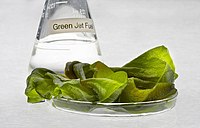
Photo from wikipedia
Cocoa butter (CB) is produced in the seeds of Theobroma cacao representing 50% of its dry weight. The lipid composition plays an important role in the physicochemical, rheological, and sensory… Click to show full abstract
Cocoa butter (CB) is produced in the seeds of Theobroma cacao representing 50% of its dry weight. The lipid composition plays an important role in the physicochemical, rheological, and sensory properties of the CB, making this fat a valuable resource for the production of chocolates, cosmetics, and pharmaceuticals. In this paper, are described experimental strategies used for a rational improvement of biomass production and fatty acids in cacao cell suspension cultures. First, the lipid profile in four cacao varieties is characterized, and then, one variety is selected to induce cell suspensions using a direct method without previous establishment of a callus phase. To improve growth and total fat production in cell suspension cultures, modified DKW media and newly designed media culture, based on the mineral concentrations of cacao seeds (cacao biomass production, “CBP”), are analyzed and compared. In addition, the effect of acetate in the lipid profile of cell suspensions is evaluated. Ultrastructural histological analysis of lipid vesicles in cacao seeds and cell suspensions is also performed. The results will show that it is feasible to establish cacao suspensions without the calli step and increase the biomass production by selecting a suitable cacao variety and tissue and also applying a new culture media formulation. In addition, it is possible to synthesize fatty acids in cell cultures and modify the lipid profile adding a precursor of the novo biosynthesis of fatty acids such as the acetate. Transmission electronic microscopy examinations and differential interference contrast microscopy analysis will demonstrate that lipid vesicles are the main reserve substance in both cacao seeds and cell suspensions.
Journal Title: Bioprocess and Biosystems Engineering
Year Published: 2017
Link to full text (if available)
Share on Social Media: Sign Up to like & get
recommendations!